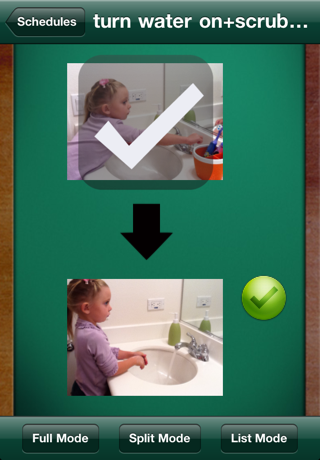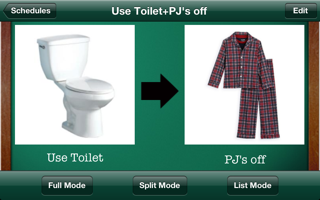First Then Visual Schedule

| Features | |
|---|---|
Price $14.99 | |
Age Range All Ages | |
App Type Learning App | |
Version Reviewed 1.1.6 | |
Android Available? |  |
Lite Version Available? |  |
Help Provided? |  |
| Sharing | |
   | |
| Bloom's Thinking Process | |
|---|---|
| Creating |  |
| Evaluating |  |
| Analysing |  |
| Applying |  |
| Understanding |  |
| Remembering |  |
| Adaptability | |
|---|---|
| Add own pictures | |
| Add own voice | |
| Add own text | |
| Includes images | |
| Review Comments | |
|---|---|
First Then Visual Schedule is one of the best scheduling apps. Children can view the schedule in three different formats.
In first- then format you can see the images side by side. In full screen the images are full sized for clearer viewing. In list mode, the child can see a written list as well as the images which is useful for older children who don't need large images.
Images: First The Visual Schedule has a library of images which you can customise. But of course you can add your own images with your own voice.
The strength of this app is it's simplicity and ease of use. It is quick to set up and you can change the order of pictures any time. Children find it easy to navigate. |
| Use | Rank (*) | |
|---|---|---|
| Schedules and Work Systems | Ranked 2nd of 47 | |
| First-then | Ranked 6th of 13 | |
| Top Apps for Parent of Children with Autism | Ranked 9th of 16 | |
| Top Apps for Psychologists | Ranked 8th of 15 | |
| Top Apps for Occupational Therapists | Ranked 12th of 14 |
(*) This app has been ranked according to its' effectiveness to achieve the learning goals and strategies listed. Some apps may rank highly for achieving a specific use and lower for other uses. Some students will learn and engage with one app more than others, because of the individual nature of us all.
| Learning App |
|---|
| Learning apps are designed for a specific purpose. The authors claim to teach a goal, skill or concept. |
| Bloom's Thinking Process |
|---|
| Bloom's Taxonomy is classification system used to explain the behaviours important in learning. Apps range from simple memory tasks such as flashcards apps through to creative apps which ask students to create an original story or video. |
| Bloom's Creating |
|---|
| The student creates new ideas, products or ways of viewing things. Activities include making, animating, designing, constructing, planning, producing and inventing. |
| Bloom's Evaluating |
|---|
| The student justifies a decision or course of action. Activities include counting to check, hypothesising, critiquing, experimenting and judging. |
| Bloom's Analysing |
|---|
| The student breaks the information into parts to explore understandings and relationships. Activities include explaining, ordering, inferring, comparing and organising. |
| Bloom's Applying |
|---|
| The student uses the information in a new situation. Activities include implementing, carrying out, using, illustrating, classifying and categorising. |
| Bloom's Understanding |
|---|
| The student comprehends the new information. Activities include describing, predicting showing understanding use a multiple choice. |
| Bloom's Remembering |
|---|
| The student recalls information they know. Activities include matching, 'fill in the blank', making a choice, answering using a multiple choice, naming a group. |
| Learning Connection |
|---|
| How well does the app teach the targeted skill or concept? This is the area where we refer to current research and pedagogy to evaluate the efficacy of the app. |
| Authenticity |
|---|
| Authenticity looks at the manner in which skills are learnt. Authentic apps use real life or genuine activities. Students learn in context rather than in a contrived or rote fashion (such as flashcards). |
| Feedback |
|---|
| Feedback needs to be specific and result in improved performance. Feedback should be supportive and encouraging rather than negative. Data should be available to support decision making. |
| Differentiation |
|---|
| Differentiation is the ability to customise the app to suit the student. The ability to record you voice, customise text, add pictures and alter settings enables individualisation of the app. |
| User Friendliness |
|---|
| User friendliness is a measure of how well a student can use the app independently. Some apps are simply intuitive to use. Others include audio or visual prompts which support the student. |
| Motivation |
|---|
| All apps are engaging the first time they are played. However, students with diverse learning needs may need to return to the app many times. Motivating apps offer rewards,games or incentives. |
| Schedules and Work Systems |
|---|
| Picture schedules use pictures to show a list of activities in a time sequence. Works systems are minischedules which give a list of steps within an activity. These systems usually include a way for the student to check off when they have completed an activity (this is called task completion) and a way to show the student that the schedule or activity has finished. |
| First-then |
|---|
| First-then schedules are based on the principle that students will do a less preferred activity (first activity) if followed be a preferred activity (then activity). The first-then card is usually divided into two halves. The word ‘first’ is written on top of the first card and the word ‘then’ is written on top of the second card. |
| Top Apps for Parent of Children with Autism |
|---|
| This is a list of the Top App Parents of Children with Autism |
| Top Apps for Psychologists |
|---|
| This is a list of the Top Apps for Psychologists |
| Top Apps for Occupational Therapists |
|---|
| This is a list of the Top Apps for Sensory Skills and Social Skills |
| Domain | Score | Details | |
|---|---|---|---|
| Learning Connection | 4 | First Then Visual Schedule presents visual schedules very well. Children can check off when they have completed a task. Adults can quickly delete a task or change the order if there is a change of plan. | |
| Authenticity | 2 | The child ticks off when they have completed a task to show they know that the task is finished. | |
| Feedback | 1 | Feedback is not provided in scheduling apps. | |
| Differentiation | 4 | This app allows you to choose images from a nice image library. Add you own images, text and voice. | |
| User Friendliness | 4 | On the home screen the child can see a list of schedules with an image. All screens are uncluttered and easy to navigate. I like the inclusion of an arrow between images in full and split mode. This visually connects the pictures in the schedule. | |
| Motivation | 3 | The chalk board appearance has the feel of a schedule for learning. The adult may need to add a reward at the end of the schedule to encourage the child to use this schedule for challenging tasks. | |
| From the App Store | |
|---|---|
 | |
Developer Good Karma Applications, Inc | |
App Store Rating (from 1 reviews) | |
Current Version Rating (from 1 reviews) | |
Current Version 1.1.6 | |
| Developer's Description | |
|---|---|
| First-Then visual schedule application is designed for caregivers to provide positive behavior support. For individuals with communication needs, developmental delays, Autism or those who benefit from a structured environment; visual schedules serve to increase independence and lower anxiety during transitions through different activities. This app was designed for use for the iPhone and iPod. If you are looking for a version that works on these devices as well as the iPad, please check out: FTVS HD: First Then Visual Schedule HD Fully Customizable! *Use your own photos or add photos from the built in Internet image search feature. *Record your own voice to the images. *Create as many schedules as you need. *Change the order of a schedule, anytime! *Checklist feature. *"Save and Share" schedules via "File Sharing" on iTunes. * Backup schedules via iCloud. * Email a PDF copy of a schedule to print off at home. Visual schedules provide positive behavior support through the use of images that show daily events(i.e. morning routine or therapy schedule) or steps needed to complete a specific activity, (i.e. using the restroom). User can *record their own voice*, *add their own images* from their computer, internet image importer or iPhone/ iTouch camera, or simply use images from the application’s stock library to create a schedule. Flexibility of obtaining images allows for schedules to be created “on-the-go” to help transition through unexpected changes in a routine. Within a saved schedule, as many images as needed can be used to create the steps needed to complete a task. There is also the option of choosing different formats for use in each of the schedules. Format options can be changed at a moments notice depending upon the preference of the user: *THREE DIFFERENT FORMATS:* *FULL SCREEN*- In this format a larger image appears on the screen. User accesses next image on schedule by simply swiping screen to the left. *FIRST-THEN SCREEN*- This format shows two images side by side with an arrow between images to guide the sequence of the activity. This is often a visual that is given to portray conditional statements. For example, ”First bathroom, then computer”. This helps let the user know what is coming up next. Split screen can be read left to right with captions underneath each image, or top to bottom of screen with schedule scrolling down to see next image in the schedule. *LIST SCREEN*- This screen allows images to be listed in a list format where four images are placed on schedule. This is great for a schedule for a child that is very familiar with a system of picture exchange or is not as easily distracted by upcoming activities. *VOICE CAN BE ADDED TO IMAGES *and added to the images to help further reinforce schedule and to aid with receptive and expressive language acquisition. Please note, that if you have an iTouch that you will need to purchase a microphone to record sound. *CHECKLIST FEATURE* can be turned "on" or "off" within the "settings" menu. You can add a checkmark by a task to visually indicate that the task is completed. *ADD YOUR OWN PHOTOS* by using the iPhone’s built in camera or download images from your personal computer to the camera roll or use the apps internet image importer. * * *STOCK IMAGE LIBRARY* consists of common images that can be immediately accessed to create schedules. In addition, for reference we have added three example schedules (contain no audio-output) that can be deleted or edited. We at *Good Karma Applications* have an intimate understanding of the needs of those leading exceptional lives. It is our mission to provide low-cost, effective applications to that special group of individuals. We hope that our applications will enhance the lives of those leading exceptional lives, and in doing so, provide support for those who love and care for them. |
|
Disclaimer: The evaluations and rankings information provided here are based solely on the opinion of the author and are for informational purposes only. Families should seek professional advice before making decisions regarding interventions for their child.






